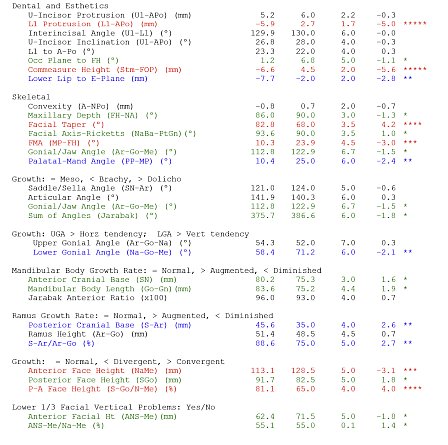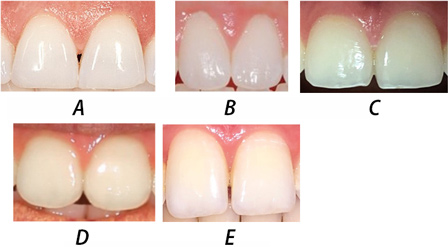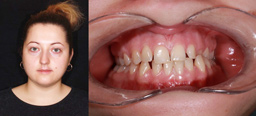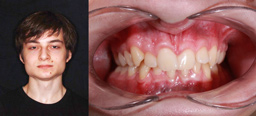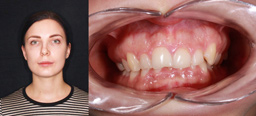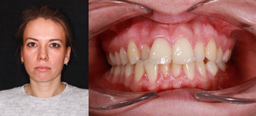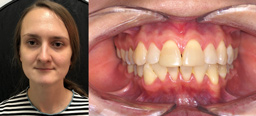DOI:
10.37988/1811-153X_2020_4_55Assessment of the dependence of the shape of the central incisors of the upper jaw on the type of structure of the body and skull
Abstract
Is it true or myth that tall people with an asthenic type of complexion have an elongated face, long and narrow teeth, and low ones have a hypersthenic type of complexion, short and wide teeth. The article assesses the dependence of the forms of the central incisors of the upper jaw on the shape of the head, type of growth of the jaws and types of complexion of a person. Materials and methods. To assess the shape of the central incisors of the upper jaw, a group of 36 people was selected: 9 men and 27 women aged 15 to 45 years. On the basis of the obtained calculations, parameters were identified that assess the type of jaw growth: SGo: NMe, ML-NSL, ∠Bjork (NSAr + SArGo + ArGoMe), NL-ML, ∠NGoMe, NBa/PtGn. Conclusions. The most common form of the maxillary central incisors is triangular and square. The rarest shape of the central incisors is round and oval. Counterclockwise rotation of the mandible is associated with the most common tooth shapes. Most often, the triangular shape of the central incisors of the upper jaw is combined with a neutral type of growth, and the square shape — with a horizontal one. An unambiguous relationship between the shape of the central incisors of the upper jaw and the shape of the head was not revealed. Patients with a square shape of the central incisors of the upper jaw more often corresponded to the asthenic type of build. 6. Patients with oval, rectangular and triangular shapes of the central incisors of the upper jaw more often corresponded to the normosthenic type of constitution. For patients with the vertical type of growth of the jaw bones, the hypersthenic type of constitution was more common.Key words:
growth type, growth type forecast, shape of heads, Garson head shape, shape of upper central incisorsFor Citation
Introduction
It is true or myth that tall people with an asthenic type of bodily constitution have an elongated face, long and narrow teeth, and the people of short stature have a hypersthenic type of bodily constitution, short and wide teeth. The article evaluates the dependence of the shape of the central incisors of the upper jaw on the head shape, the type of growth of the jaws and types of human constitution.
When a person smiles, the center of visual attraction is the contour of the maxillary central incisors. Due to their position, the maxillary central incisors create the illusion that these teeth are the lightest and largest teeth in the mouth, making them the dominant teeth in a smile [1, 18].
Balancing the proportions of the appearance of the teeth is fundamental to creating an aesthetically pleasing smile [1, 3, 6]. The golden proportion, which sets the value to 1: 1.618 (R.M. Ricketts) [5], is considered ideal and is the most commonly used proportion. However, the golden proportion is only a guideline, so the dentist shall not be limited to it and forget other important aspects [2, 4].
Although all teeth shall be in proportion to one another, they shall also be in proportion to the face [8, 10, 20]. Significant differences in the size of teeth in relation to the face can affect the obtaining of smile aesthetics [7, 12, 15]. It is important to know the average width and height of the crowns of the anterior teeth, since they correspond to the basic geometric shapes, which will allow the dentist to detect features that are not aesthetically pleasing, and to achieve a concluding result, that eliminates disharmony [9, 17, 19].
The shape of the maxillary central incisors can be classified as square, triangular, oval, barrel-shaped (round) and rectangular, and in most cases there is some similarity between dental morphology and facial morphology [7, 17, 21, 22].
In addition, the face can be classified in shape as square, triangular or oval [11—14]. In 1914 J.L. Williams suggested that there was a relationship between the shape of the face and the shape of the teeth (J.L. Williams, 1914; V.A. Cesario, G.H. Latta, 1984). However, P.N. Sellen et al. mentioned that there was not necessarily any relation between the shape of the face and the teeth, and other aspects that make up the aesthetic analysis shall be considered with a view to establish the final shape of the teeth to be restored (P.N. Sellen, D.C. Jagger, A. Harrison, 1998; F. Mavroskoufis, G.M. Ritchie, 1980).
The aim of the study is to assess the relationship between the shape of the maxillary central incisors and the body and skull type of structure.
Materials and methods
To assess the shape of the central incisors of the upper jaw, a group of 36 people was selected, including 9 men and 27 women aged 15 to 45 years. The prevalence rate of different types of jaw growth in the group was almost equal.
The assessment was made on the basis of data obtained using the method of computed tomography using the KaVo 3D eXam equipment. Patients were assigned a Cone Beam Computed Tomography study, size 23/17 (extended). The calculation of the parameters was carried out using computer software (Fig. 1), using the Ricketts — Roth — Jarabach analysis (Fig. 2).
On the basis of the calculations obtained, parameters were identified assessing the type of jaw growth: SGo:NMe, ML-NSL, ∠Biork (NSAr + SArGo + ArGoMe), NL-ML, ∠NGoMe, NBa/PtGn.
The parameters have been calculated:
- SGo:NMe — the ratio of the face’s back height to its front height. The type of rotation of the mandible counterclockwise or clockwise is being assessed. It is normally equal to 61—63%. SGo:NMe.
- ML-NSL — tilt of the base of the lower jaw to the base of the skull. With an increase in the angle, they speak of a hyperdivergent type of structure of the facial skeleton, or a vertical type of development. With a decrease — about the hypodivergent, or horizontal type of development. If the parameter is normal (32±5) — it’s a norm divergence.
- ∠Bjork is the total value of the angles NSAr + SArGo + ArGoMe, normally equal to 393—399°. A value above 396° indicates a tendency towards vertical growth of the jaws, and its decrease towards horizontal growth.
- ∠NL-ML — basal angle, inclination of the bases of the jaws to each other. With an increase in the angle, a hyperdivergent type of structure of the facial skeleton, or a vertical type of development, with a decrease, a hypodivergent, or horizontal type of development, if the parameter is normal (25±3) — it’s a norm divergence.
- ∠NGoMe — a lower gonial angle, normally equal to 70—76°. A value of more than 77° is typical for patients with a vertical jaw growth tendency, less than 69° — for a horizontal one.
- ∠NBa/PtGn — Ricketts face angle, normally equal to 90±2. An increase is observed with a horizontal type of jaw growth, a decrease — with a vertical one.
Apart from this, the following anthropometric data have been assessed:
- Weight
- Head shape according to Garson — determined by the ratio (n−gn)/(zy−zy)×100, where the morphological height of the face is the distance between points n and gn; the width of the face in the area of the maxillary arches is the distance between the points zy. <75.9 — dolichocephaly, 76—9 — mesocephally, 81—85.4 — brachycephaly and> 85.5 — hyperbrachycephaly (Fig. 3).
- Type of bodily constitution (asthenic, normosthenic and hypersthenic) based on the measurement of the wrist circumference of the operating arm (in asthenics it is less than 16 cm, in normosthenic — from 16 to 18.5 cm, in hypersthenic more than 17.5 cm).
- The shape of the central incisors of the upper jaw (square, rectangular, oval, barrel-shaped and triangular) — was determined by the method of visual assessment and comparative analysis (Fig. 4).
The prevalence rate of events was calculated using the standard method as a percentage.
Results and discussion
When analyzing according to Bjork, it was revealed that the square shape of the teeth was found more often with the horizontal type of growth (67%), round one — with neutral (75%), oval one — with horizontal (50%), rectangular one — with horizontal (50%) and neutral one (38%) and with a triangular shape — horizontal (55%) and neutral (45%) types of growth (Fig. 5, 6)
When analyzing according to Nl-Ml, it was revealed that the square shape of the teeth was found more often with the horizontal type of growth (67%), round one — with neutral (75%), oval one — with neutral (50%), rectangular one — with horizontal (38%) and neutral one (50%), and with a triangular shape — neutral (64%) type of growth (Fig. 7, 8)
When analyzing by NGoMe, it was found that square teeth were more common with horizontal (44%) and neutral (44%) types of growth, round one — with neutral (100%), oval one — with neutral (50%), rectangular and triangular ones — at neutral (50% and 75%, respectively) type of growth (Fig. 9, 10)
When analyzing according to NBa/PtGn, it was revealed that the square shape of the teeth occurred the same number of times with horizontal, neutral and vertical types of growth (33%), round one — with neutral (50%), oval one — with vertical (75%), rectangular one — with vertical (38%) and neutral one (50%), with a triangular shape — neutral (55%) type of growth (Fig. 11, 12).
When assessing the horizontal type of growth according to Bjork, a dependence was revealed with square (32%) and triangular (32%) shapes of the central incisors of the upper jaw, with a neutral type — a triangular shape (36%). Vertical type had inherent square, oval and rectangular shape (33%; Fig. 13, 14)
When assessing the horizontal type of growth according to Nl-Ml, a dependence was found with the square shape of the central incisors of the upper jaw (40%), with a neutral type — a triangular shape (39%). Vertical type — no clear relationship was found (square, oval and rectangular shape 33% each; Fig. 15, 16).
When evaluating the horizontal type of growth according to NGoMe, a dependence was revealed with a square (44%), triangular (33%) and rectangular (22%) shapes of the central incisors of the upper jaw, with a neutral type — a triangular shape (35%), with a vertical — rectangular shape (50%; Fig. 17, 18).
When assessing the vertical type of growth according to NBa/PtGn, a dependence was found with square (23%), oval (23%), rectangular (23%) and triangular (23%) shapes of the maxillary central incisors, with the horizontal type — square (38%) and triangular (25%) shapes (Fig. 19, 20), when assessing the neutral type of growth — triangular shape (40%; Fig. 21, 22, Tables 1, 2).
| Shape of the maxillary central incisors | Jaw bone growth type | ||
| vertical | horizontal | neutral | |
| Square | 17 | 53 | 31 |
| Round | 20 | 20 | 60 |
| Oval | 31 | 28 | 41 |
| Rectangular | 21 | 36 | 43 |
| Triangular | 17 | 27 | 56 |
| Shape of the maxillary central incisor | Growth type | Grand Total | ||
| vertical | horizontal | neutral | ||
| Square | 20 | 37 | 16 | 24 |
| Round | 13 | 8 | 17 | 13 |
| Oval | 20 | 10 | 11 | 13 |
| Rectangular | 20 | 19 | 17 | 19 |
| Triangular | 27 | 25 | 39 | 32 |
When assessing the square shape of the c maxillary entral incisors , a dependence with the hyperbrachycephalic (89%) head shape was found. When assessing the round shape — hyperbrachycephalic (75%), with oval one — hyperbrachycephalic (100%), with rectangular one — hyperbrachycephalic (75%). With triangular one — hyperbrachycephalic head shape (73%) (Fig. 23, 24).
When assessing the hyperbrachycephalic head shape according to Garson, a dependence with a square (28%) and triangular (28%) shape of the maxillary central incisors was revealed (Fig. 25, 26).
When assessing according to Ml-NSL, it was found that the square, round, rectangular and triangular shapes of the maxillary central incisors correspond to the norm (56, 100, 63 and 82%, respectively; Fig. 27, 28).
When assessing the type of growth according to Ml-NSL, a dependence was found between the normal type of growth and the triangular (36%) shape of the maxillary central incisors, antinclination was found in 43% of cases with the square shape of the maxillary central incisors (Fig. 29, 30).
When evaluating the shape of the maxillary central incisors using the SGo:NMe method, a dependence of square (89%), rectangular (63%) and triangular (82%) shapes and counterclockwise rotation was revealed (Fig. 31, 32).
When assessing the type of growth by SGo:NMe, a dependence was found between counterclockwise rotation and square (30%) and triangular (33%) shapes of the maxillary central incisors. Clockwise rotation corresponds to square (33%), rectangular (33%) and triangular (33%) shapes. The norm is round (33%) and rectangular (33%; Fig. 33, 34).
When assessing the shape of the maxillary central incisors on the type of bodily constitution, the height and weight of the subjects under study were taken into account and a relationship was revealed between square teeth and asthenic type of constitution (44%), oval and normosthenic type (50%), rectangular and normosthenic type (63%) and triangular teeth and normosthenic type of bodily constitution (73%; Fig. 35, 36).
When assessing the type of growth depending on the type of bodily constitution, a relationship was found between the vertical type of growth and the hypersthenic type of constitution (67%), the horizontal type and the normosthenic type (47%) and the neutral type of growth and the normosthenic type of bodily constitution (61%; Fig. 37, 38).
Conclusion
- The most common shape of the maxillary central incisors is triangular and square one. The rarest form of central incisors is round and oval one.
- Counterclockwise rotation of the mandible is associated with the most common tooth shapes.
- Most often, the triangular shape of the maxillary central incisors is combined with a neutral type of growth, and the square shape — with a horizontal one.
- An unambiguous relationship between the shape of the maxillary central incisors and the shape of the head has not been revealed.
- Patients with a square shape of the maxillary central incisors more often corresponded to the asthenic type of bodily constitution.
- Patients with oval, rectangular and triangular shapes of the maxillary central incisors more often corresponded to the normosthenic type of bodily constitution.
- For patients with the vertical type of growth of the jaw bones, the hypersthenic type of constitution was more often inherent.
Figures
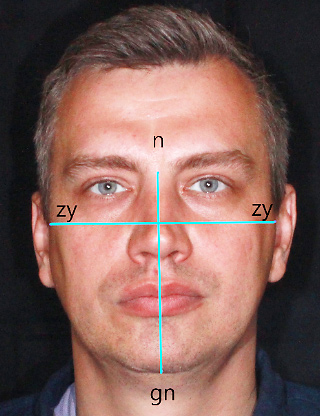
































Acknowledgements:
To “Golden Section” laboratory, Moscow, Russia
References
- Machado A.W. 10 commandments of smile esthetics. — Dental Press J Orthod. — 2014; 19 (4): 136—57. PMID: 25279532
- Murthy B.V.S., Ramani N. Evaluation of natural smile: Golden proportion, RED or Golden percentage. — J Conserv Dent. — 2008; 11 (1): 16—21. PMID: 20142879
- Geld P.V., Oosterveld P., Heck G.V., Kuijpers-Jagtman A.M. Smile attractiveness. Self-perception and influence on personality. — Angle Orthod. — 2007; 77 (5): 759—65. PMID: 17685777
- Fayyad M.A., Jamani K.D., Agrabawi J. Geometric and mathematical proportions and their relations to maxillary anterior teeth. — J Contemp Dent Pract. — 2006; 7 (5): 62—70. PMID: 17091141
- Wolfart S., Thormann H., Freitag S., Kern M. Assessment of dental appearance following changes in incisor proportions. — Eur J Oral Sci. — 2005; 113 (2): 159—65. PMID: 15819823
- LaVere A.M., Marcroft K.R., Smith R.C., Sarka R.J. Denture tooth selection: an analysis of the natural maxillary central incisor compared to the length and width of the face. Part I. — J Prosthet Dent. — 1992; 67 (5): 661—3. PMID: 1527751
- Gonçalves L.C., Gomes V.L., De Lima Lucas B., Monteiro S.B. Correlation between the individual and the combined width of the six maxillary anterior teeth. — J Esthet Restor Dent. — 2009; 21 (3): 182—92. PMID: 19508262
- McGowan S. Characteristics of teeth: A review of size, shape, composition, and appearance of maxillary anterior teeth. — Compend Contin Educ Dent. — 2016; 37 (3): 164—171. PMID: 26977896
- Frindel F. The unattractive smile or 17 keys to the smile. — Orthod Fr. — 2008; 79 (4): 273—81 (in French.). PMID: 19061631
- Liao P., Fan Y., Nathanson D. Evaluation of maxillary anterior teeth width: A systematic review. — J Prosthet Dent. — 2019; 122 (3): 275—281.e7. PMID: 30955941
- Varjão F.M., Nogueira S.S., Russi S., Filho J.N.A. Correlation between maxillary central incisor form and face form in 4 racial groups. — Quintessence Int. — 2006; 37 (10): 767—71. PMID: 17078274
- Witt M., Flores-Mir C. Laypeople’s preferences regarding frontal dentofacial esthetics: tooth-related factors. — J Am Dent Assoc. — 2011; 142 (6): 635—45. PMID: 21628684
- Anderson K.M., Behrents R.G., McKinney T., Buschang P.H. Tooth shape preferences in an esthetic smile. — Am J Orthod Dentofacial Orthop. — 2005; 128 (4): 458—65. PMID: 16214627
- Parrini S., Rossini G., Castroflorio T. et al. Laypeople’s perceptions of frontal smile esthetics: A systematic review. — Am J Orthod Dentofacial Orthop. — 2016; 150 (5): 740—50. PMID: 27871700
- Gobbato L., Tsukiyama T., Levi P.A. Jr. et al. Analysis of the shapes of maxillary central incisors in a Caucasian population. — Int J Periodont Restorat Dent. — 2012; 32 (1): 69—78. PMID: 22254227
- McGowan S. Characteristics of teeth: a review of size, shape, composition, and appearance of maxillary anterior teeth. — Compend Contin Educ Dent. — 2016; 37 (3): 164—72. PMID: 26977896
- Rozhkova K.I., Slabkovskaya A.B., Persin L.S., Zakharov A.N., Avetisyan K.K. Assessment of the perception of the upper central incisors shape as an important element microesthetic smile. — Clinical Dentistry (Russia). — 2019; 1 (89): 16—9 (In Russ.).
- Zhdanov S.E., Zhdanova M.L., Lukinykh L.M. The meaning of the correlation of the form of face and teeth for aesthetic restoration. — Medical Almanac. — 2012; 5 (24): 225—6 (In Russ.).
- Domenyuk D.A., Vedeshina E.G., Dmitrienko S.V. Correlation of teeth sizes with the parameters of the dentition arches and maxillofacial area according to the results of a study of native preparations of the skull. — Kuban Scientific Med Bul. — 2016; 2 (157): 72—80 (In Russ.).
- Masterova I.V. Aesthetic parameters of teeth and smile of the Europoid and Mongoloid races: master’s thesis. — Moscow, 2005. — 87 p. (In Russ.).
- Ryakhovsky A.N., Kalacheva Ya.A. Visual perception of dentition esthetic parameters (part 1). — Stomatology. — 2015; 3: 36—40 (In Russ.).
- Ryakhovsky A.N., Kalacheva Ya.A. Visual perception of dentition esthetic parameters (part 2). — Stomatology. — 2015; 4: 70—4 (In Russ.).

